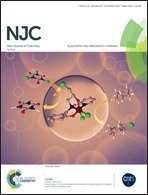The role of non-covalent interaction for the adsorption of CO2 and hydrocarbons with per-hydroxylated pillar[6]arene: a computational study†
Abstract
A systematic study has been performed with DFT calculations for the physisorption of CO2, CH4, and n-butane gases by pillar[6]arene (PA[6]) in gas phase. The DFT(B3LYP)-D3 calculations showed that CO2 and n-butane could be adsorbed more efficiently inside the cavity of PA[6] compared to the CH4 molecule. The order of the binding energies of the adsorbed gases by PA[6] is n-butane > CO2 > CH4 at 1 atm and 298 K. The hydroquinone units of PA[6] play an important role in the adsorption of the gas molecules. The strong cooperative binding of n-butane compared to CO2 and CH4 inside the cavity of PA[6] facilitates adsorption of n-butane inside the PA[6] cavity. The structural analysis of the gas-adsorbed PA[6] shows that the carbon atom of CO2 is in close proximity to the aromatic hydroquinone ring of PA[6], and the oxygen atom of CO2 is in close contact to the hydrogen atom of the hydroxyl group of the hydroquinone unit of PA[6]. Similarly, the hydrogen atoms of the hydrocarbon (methane and n-butane) closely interact with the aromatic Pi-electron walls of the hydroquinone ring of PA[6], and the electronegative oxygen (O) atoms of the hydroxyl group (–OH) belong to the hydroquinone unit of PA[6]. The calculated results show that four CO2, four CH4, and two n-butane molecules can reside inside the cavity of PA[6]. The atoms in a molecule (AIM) analyses performed with adsorbed CO2, CH4 and n-butane inside the cavity of PA[6] reveal the strong ‘closed shell’ type interactions for n-butane to be held inside the PA[6] cavity. In addition to adsorption, the desorption of CO2, CH4, and n-butane from PA[6] was accounted with the desorption enthalpies (ΔHDE) calculated per gas molecule, indicating that both adsorption and desorption are feasible in nature. The DFT studies of PA[6] with CO2, CH4, and n-butane gases may help to understand the development of new design materials that can efficiently capture and separate such gases. The (B3LYP-D3) computed results corroborate the experimental observations that n-butane can adsorb better with PA[6] compared to CH4 gas molecules. The associative butane–butane interactions seem to be superior over the CO2–CO2 interactions inside the PA[6] cavity that promotes the adsorption of hydrocarbons.
![Graphical abstract: The role of non-covalent interaction for the adsorption of CO2 and hydrocarbons with per-hydroxylated pillar[6]arene: a computational study](/en/Image/Get?imageInfo.ImageType=GA&imageInfo.ImageIdentifier.ManuscriptID=C7NJ01744H&imageInfo.ImageIdentifier.Year=2017)


 Please wait while we load your content...
Please wait while we load your content...